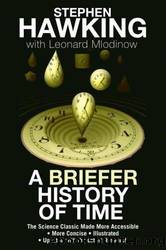A briefer history of time by Stephen Hawking

Author:Stephen Hawking [Stephen Hawking]
Language: eng
Format: epub
Tags: Sciences
ISBN: 9780553385465
Published: 2008-05-13T17:29:39+00:00
Tidal Forces
Since gravity weakens with distance, the earth pulls on your head with less force than it pulls on your feet, which are a meter or two closer to the earthâs center The difference is so tiny we cannot feel it, but an astronaut near the surface of a black hole would be literally torn apart.
Sometimes, when a very massive star collapses, the outer regions of the star may get blown off in a tremendous explosion called a supernova. A supernova explosion is so huge that it can give off more light than all the other stars in its galaxy combined. One example of this is the supernova whose remnants we see as the Crab Nebula. The Chinese recorded it in 1054. Though the star that exploded was five thousand light-years away, it was visible to the naked eye for months and shone so brightly that you could see it even during the day and read by it at night. A supernova five hundred light-years awayâ one-tenth as farâwould be one hundred times brighter and could literally turn night into day. To understand the violence of such an explosion, just consider that its light would rival that of the sun, even though it is tens of millions of times farther away. (Recall that our sun resides at the neighborly distance of eight light-minutes.) If a supernova were to occur close enough, it could leave the earth intact but still emit enough radiation to kill all living things. In fact, it was recently proposed that a die-off of marine creatures that occurred at the interface of the Pleistocene and Pliocene epochs about two million years ago was caused by cosmic ray radiation from a supernova in a nearby cluster of stars called the Scorpius-Centaurus association. Some scientists believe that advanced life is likely to evolve only in regions of galaxies in which there are not too many starsâ"zones of life"â because in denser regions phenomena such as supernovas would be common enough to regularly snuff out any evolutionary beginnings. On the average, hundreds of thousands of supernovas explode somewhere in the universe each day. A supernova happens in any particular galaxy about once a century. But thatâs just the average. Unfortunatelyâfor astronomers at leastâthe last supernova recorded in the Milky Way occurred in 1604, before the invention of the telescope.
The leading candidate for the next supernova explosion in our galaxy is a star called Rho Cassiopeiae. Fortunately, it is a safe and comfortable ten thousand light-years from us. It is in a class of stars known as yellow hypergiants, one of only seven known yellow hypergiants in the Milky Way. An international team of astronomers began to study this star in 1993. In the next few years they observed it undergoing periodic temperature fluctuations of a few hundred degrees. Then in the summer of 2000, its temperature suddenly plummeted from around 7,000 degrees to 4,000 degrees Celsius. During that time, they also detected titanium oxide in the starâs atmosphere, which they believe is part of an outer layer thrown off from the star by a massive shock wave.
Download
This site does not store any files on its server. We only index and link to content provided by other sites. Please contact the content providers to delete copyright contents if any and email us, we'll remove relevant links or contents immediately.
| Aeronautics & Astronautics | Astronomy |
| Astrophysics & Space Science | Comets, Meteors & Asteroids |
| Cosmology | Mars |
| Solar System | Star-Gazing |
| Telescopes | UFOs |
Tools of Titans by Timothy Ferriss(8304)
Turbulence by E. J. Noyes(7978)
Secrets of Antigravity Propulsion: Tesla, UFOs, and Classified Aerospace Technology by Ph.D. Paul A. Laviolette(5333)
Astrophysics for People in a Hurry by Neil DeGrasse Tyson(5151)
Room 212 by Kate Stewart(5071)
Design of Trajectory Optimization Approach for Space Maneuver Vehicle Skip Entry Problems by Runqi Chai & Al Savvaris & Antonios Tsourdos & Senchun Chai(5037)
Pale Blue Dot by Carl Sagan(4954)
The David Icke Guide to the Global Conspiracy (and how to end it) by David Icke(4657)
A Journey Through Divination and Astronomy by Publishing Pottermore(4363)
Goodbye Paradise(3761)
Apollo 8 by Jeffrey Kluger(3668)
COSMOS by Carl Sagan(3589)
The Five People You Meet in Heaven by Mitch Albom(3520)
Losing the Nobel Prize by Brian Keating(3518)
How to Read Water: Clues and Patterns from Puddles to the Sea (Natural Navigation) by Tristan Gooley(3433)
Brief Answers to the Big Questions by Stephen Hawking(3393)
How to Read Nature by Tristan Gooley(3292)
The Order of Time by Carlo Rovelli(3162)
A Brief History of Time by Stephen Hawking(2992)
